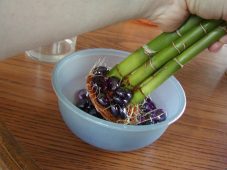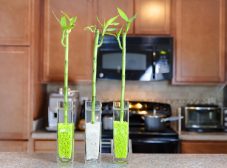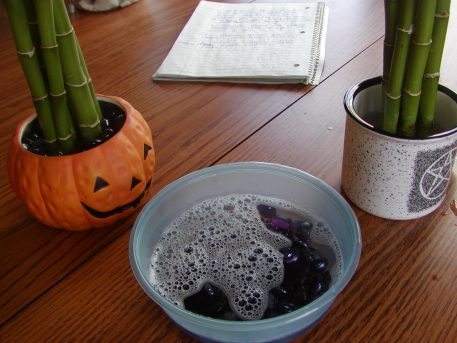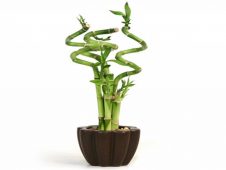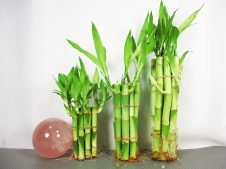Dracaena sander is a true find for a gardener who is beautiful and easy to care for. The trunk of the plant resembles the appearance of bamboo, only it is a little thicker, but grows just as fast. Due to this feature and its resemblance, the dracaena sander is sold in flower shops under the name “Happy Bamboo”.
Material Content:
Dracaena Sander: types and varieties
Dracaena Sander differs from other species in its green trunk. It is quite flexible, so it is sometimes grown in the form of fancy spirals.
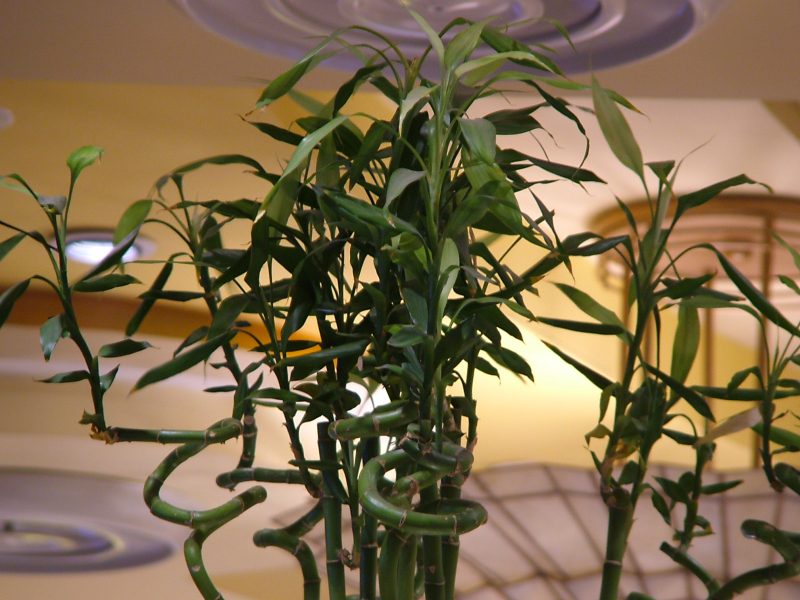
This is the most common variety of indoor dracaena, in which the following varieties are distinguished:
- Golden Lotus - leaves are striped, green-yellow, with a predominance of yellow;
- Whiskers - in the middle of each sheet plate is a light bar;
- Boringuensis - green leaves are bordered by a dark green stripe;
- Moon Shine - white and silver stripes are visible on green leaves;
- Lucky Gold - there is a yellow border along the edge of light green leaves, there may be yellow strokes in the middle of the sheet;
- White - white leaves with a wide light green stripe in the middle;
- Celes is a green variety that is most often sold under the name "happy bamboo."
The leaves of the dracaena sander are usually slightly curved or twisted. At room conditions, it rarely blooms.
The nuances of growing happy bamboo
Interesting compositions are grown from Dracaena sander, with green trunks bent in a spiral shape, at the end of which straight vertical shoots grow.Sometimes the trunks of dracaena are twisted into intricate nets, like ficus trunks. Such a variety of forms is possible due to the plasticity of the plant, its unpretentiousness and rapid growth.
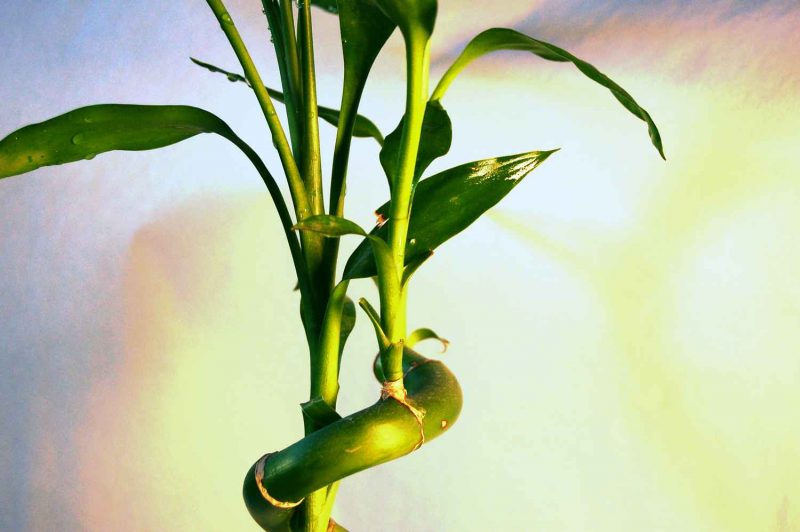
On sale you can find compositions of several dracaena trunks planted nearby, cut at different heights that resemble pyramids. It is better to transplant such plants immediately into separate flower pots, they will interfere with each other's growth.
Read also: bamboo, houseplant, care
Caring for Dracaena Sander at home
For a year, indoor bamboo with good care can grow by 10 cm. Fast-growing young shoots can be given an unusual shape.
Dracaena sander is very hygrophilous and unpretentious, there is experience in growing it in water without soil.
But for a long time such an existence of a flower is not very useful. Otherwise, caring for a happy bamboo differs little from growing other species of dracaena.
Ground and pot requirements
The volume of the new pot should be several centimeters larger than the previous one. It can be from any material - ceramics, clay, plastic or fireclay. The dracaena pot must have drainage holes.
For planting, they buy special soil for dracaena in a flower shop.
If the land is used from the garden, it must be decontaminated by calcination, and 2 parts of sand added to 1 part of the soil. It is in such light ground that dracaena will feel good.
Temperature, humidity and lighting
Dracaena are plants of the tropics and subtropics; therefore, the optimum temperature for their cultivation is + 22–24 ° C. Dracaena loves sprinkling and spraying, is afraid of drafts.
Variegated species require more sun than ordinary green plants. And dracaena with green leaves will feel better in partial shade.
Watering a plant
In summer, the plant needs to be watered abundantly. As soon as the topsoil dries, water the flower with clean water at room temperature. The frequency of watering depends on the humidity and air temperature in the apartment. In summer, you can water dracaena every other day. All excess water from the pan must be poured. In winter, watering should be moderate.
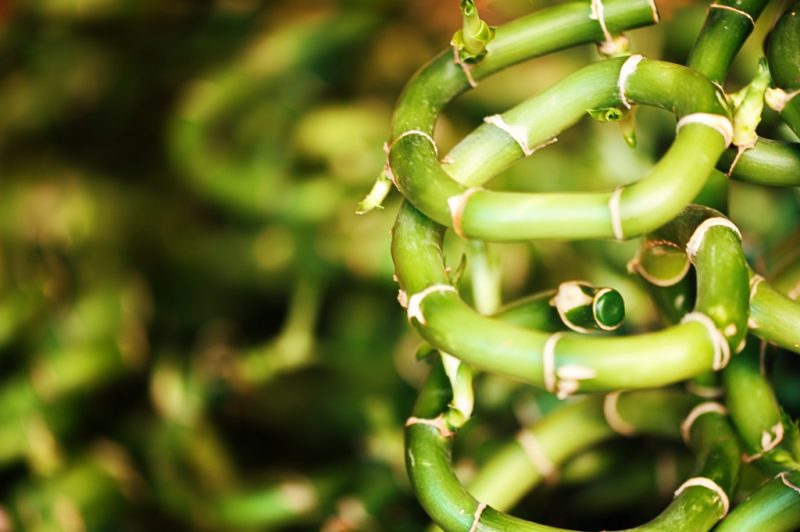
- It is advisable to water the plant in the morning.
- Water temperature should be at room temperature or 1-2 degrees higher.
- Dracaena loves spraying warm water over leaves.
- In winter, when the air is dry, spraying can be done daily, making sure that a lot of moisture does not get on the soil.
Fertilizer and fertilizer
Fertilize dracaena with a frequency of 2 times per month. If it grows in water, add fertilizer directly to the water, and after one or two days replace it with clean one.

Use liquid top dressing for decorative and deciduous crops. Dilute them in the dosage indicated on the package so as not to burn the roots of the plant. A new fertilizer is always induced in a lower concentration than the manufacturer advises in order to check the reaction of the plant.
Well perceives dracaena foliar application. They are alternated with root ones, spraying the leaves in the early morning or evening to avoid burns to the leaves. Usually, for the foliar application, the same preparations are used as for the root, but in a weaker concentration.
Transplanting happy bamboo
About a month after buying dracaena in the store, you need to transplant it. A transplant pot is needed 1 cm more than the previous one.
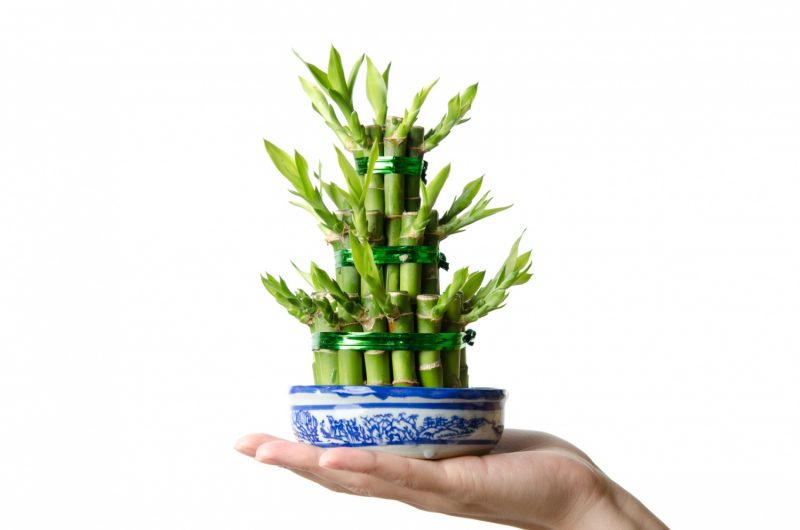
- Drainage is poured on its bottom, and on top is a little soil for dracaenas.
- Then the plant is carefully removed from the old pot, they are looked so that sponges are not tied to its roots (if they are left, the roots will begin to rot).
- They put the dracaena in a new flower pot, fill it with earth. They do not press hard so that the earth passes water well.
Winter care
In winter, just like in summer, dracaena loves warmth. She needs moist air, therefore, if there is no humidifier in the room, the dracaena is sprayed from the spray bottle with warm water in the morning.
They protect the plant from cold drafts. Watering is slightly reduced, as in winter the soil dries longer. You can fertilize 1 time per month or completely stop feeding until March.
Breeding Dracaena Sander
Dracaena is well propagated by cuttings.It can also grow into a full-fledged plant from a small fragment of the stem.
Lateral shoots of dracaena are broken off for reproduction, and placed in water or immediately placed in a moist substrate.
Before planting, a fresh cut is treated with wood ash and a root formation stimulator. Then it is placed vertically in a wet substrate, deepened by a few centimeters.
It is not necessary to make a greenhouse for a seedling. It must be sprayed daily from a spray bottle and watered with clean water. When it begins to grow, we can conclude that the rooting was successful.
Problems that growers may encounter when growing
No wonder Dracaena Sander is called the bamboo of happiness. This plant needs little in order to successfully grow and delight with its beauty.
But even when growing it, problems can arise:
- Leaves turn yellow. This is a sign of insufficient watering or lack of nitrogen in the soil.
- The ends of the leaf plates dry, turn brown. The room is too dry.
- Leaves curl. A big difference between day and night temperatures.
- Dry spots on the leaves. These are burns from direct sunlight.
- Leaf drying out. The result of insufficient watering or defeat by pests and diseases.
Weakened plants, which do not receive fertilizing for a long time, are especially susceptible to pest attack.
Pests, diseases and methods of dealing with them
Dracaena Sander is very hardy. But too dry or cold air in the apartment, pest-infected indoor flowers in the neighborhood can lead to diseases.
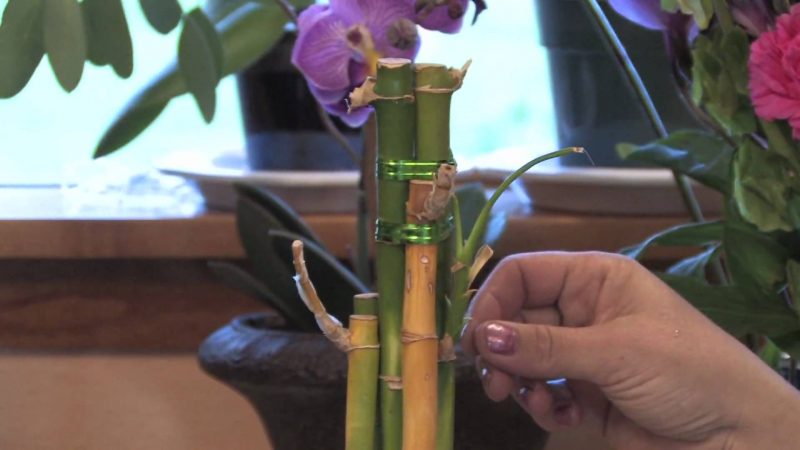
Rotting of leaves and trunk is rare. If the soil in the pot is too dense and the drainage is poor, the roots may become diseased. In this case, an unpleasant odor will start to come from the earth. The plant must be immediately removed from the pot, rinse the roots under warm water and put in water with fertilizer and fungicide. The next day, replace the solution with clean water. If the plant feels normal, you can transplant it in a week or two into fresh soil with good drainage.
When dracaena is damaged by pests (thrips, spider mites, foottails and other insects that can harm the plant), it is treated with safe insecticides. Sprayed, opening the windows, "Fitovermom" or another drug purchased at a flower shop.
Dracaena sandera or happy bamboo will please with its unpretentiousness and love of life. It is easy to care for her, you can form fantastic trees with spiral trunks. Such a home "pet" will please the eye and will not cause much trouble.



